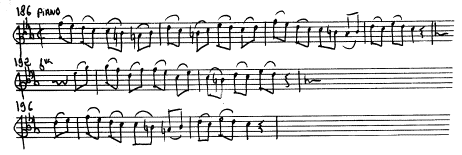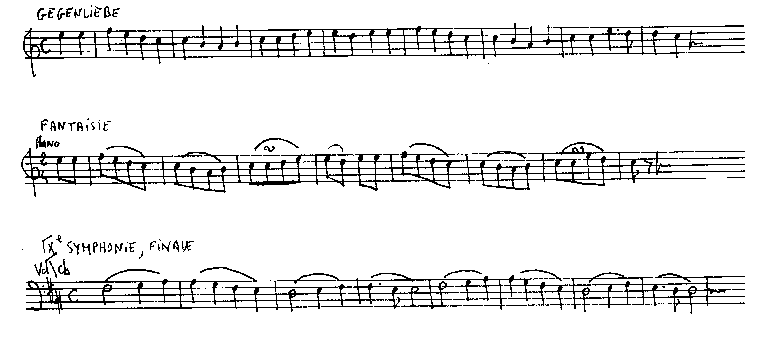As we have already mentioned earlier, the
Finale is a theme
and variations encompased in the
form of a transcendant lied.
A
Introduction : allegro,
c minor, bars 27 to 52 .
It consists of a dialogue between orchestra
and piano, the latter oposing an orchestral
theme and staccato crotchets and quavers in
an expressive phrase quasi recitando.

The theme : meno
allegro, C major, bars 60 to 76.
It is preceded by calling motives (2
crotchets) on horn, oboe then the piano announces
the beginning of the theme. It may be seen
that these calls are an evocation of symbolic
masonic elements (see above).
The theme is divided into four parts
of 8 times each in a melodic configuration:
a : antecedant then consequent
b : centered part on the start of
the theme and finishes on a pedal point
in agreement with the cadence.
a' : reprise of the consequent of
the theme

The strict variations.
B
This central part consists of three free
variations connecting to development, commenting
on the thematic material.
Free variation 1 :
bars 185 to 290, allegro
molto, piano and orchestra, modulating.
This variation is divided into four
periodes :
1)
bars 185 to 200, c minor.
Piano and orchestra converse in pure concertante
style and always conserve the architecture
of the original theme.

2) bar 200 to 219, c minor to B major.
This part is a modulating bridge based
on the calling theme (2 crotchets) preceding
the exposition of the theme.
3) bars
219 to 250, B major to a minor.
The start of the theme, purified, and
here the subject of the variation :


It is then broken up and distributed
amongst the desks of the violins and violas

4) concluding phase : bars 250
to 290, a minor.
The inspiration for this melodic idea
(cellos and double basses) is sustained by
the harmony in the chords and interrupted
by the interventions of the piano

Free variation 2 :
bars 291 to 321, allegro
ma non troppo, 6/8, a minor.
The poetry and ease of delicacy of
this variation evokes the instrumental romance
which developed in instrumental and chamber
music in the second half of the 18th
century. In the very intimate passage, the
orchestration, the type of chamber music is
largely left to a dialogue in the winds (clarinets
and bassoons) and the piano. The theme, entrusted
to the first clarinet, does not appear here
as a fillagree.
1st period : bars 291 to
307.

2nd period :
bars 307 to 316. Expressive commentary, lyric,
entrusted to the piano.
Period of waiting (bar 316 to 321) announces
the rhythmic motive used by the following
variation.

Free variation 3 :
bars 322 to 388, Marcia, assai vivace, 2/4,
F major.
1st period : bars 322 to
338.
The first phase of the variation
is close to the preoceding strict variation,
the melodic and structural elements of the
theme are more or less conserved. The theme
of martial aspect is punctuated by the syncopated
strings destabilising the metric accentuation,
a rhythmic device much prized by the composer(the
+ corresponds to the chords in the strings).

(les + correspondent aux accords
des cordes)
Interlude : bars 337 to 346 ;
concertante commentary with alternating
piano/tutti.
Bars 346 to 357 : reprise of
bars 334 to 337 with conclusion and echo.
2nd period (codetta):
bars 357 to 388.
This preorassion is a contrasting
episode, legato and expressive, where a
distant reminder of the original theme seems
about to break out.

A'
Allegro : bars 389
to 397 ; truncated and modified citation
of the instroduction to A (27-52)
Allegro ma non troppo (quasi andante
con moto) : bars 398 to 408 ;
citation of the chords which precede the announement
of the theme (A : bars 53 to 57) with
supression of the pedal point, agreeing with
the arpeggio accompaniment in the piano.
The strict variations with choir.
Codetta and Coda.
The two parts follow eachother
and a subtle sequence which only and attentive
reading of the text can locate:
The
Codetta.
It procedes by a repetition of the
two first lines of the sixth verse with
literary liberties. At bar 490, an acceleration
of the tempo (Presto) allows a clever slide
towrds the last part of this work.
1st period : bars 455 to
474, orchestral and choir dialogue with
a modification of the text (Nehmt
hin, ihr schönen Seelen, Nehmt hin, die
Gaben schöner Kunst)
2nd period : bars 474 to
482), entry and irregular imitation (tenor/soprano)
on the two fisrt lines of the sixth verse.
Note that the melody is sung by the soprano,
reprise by the following in the Coda, directly
inspired by the allegretto
of the song Seufzer
eines Ungeliebten und Gegenliebe:

3rd period :
bars 482 to 494 ; tutti, on the two
first lines of the sixth verse, Nehmt
replaces Froh .
The Coda.
(bar 494)
This last part marks the apotheosis
of the Fantasy,
affirmed by the optimistic charater of the
last verse of the poem of Kuffner where
the power of a universal god permits moral,
spiritual and mystical redemption of man
in order to accede to the fraternity. By
a careful figuration Kraft
(power) and Götter
(God) are musically depicted, constituting
the expressive summit (climax)
of this coda.
1st period : bars 494 to
530, tutti.
2nd period : bars 530 to
554, reprise of bars 474 to 490 of the codetta
3rd period :
bars 554 to 596, reprise of bars 494 to
530 with a change in the text.
Preorassion : bar 596.












